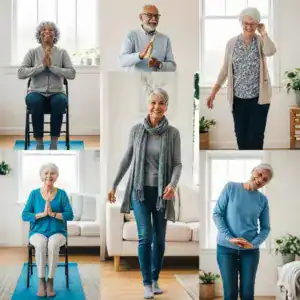
Part of aging is the decline in many areas of your loved one’s physical functions. If you’ve noticed that their vision isn’t as great as before, their memory isn’t as sharp, they forget things, and it takes them longer to clean their home — it may indicate that they need the help of a geriatric occupational therapist to improve their fine and gross motor skills.
Stroke management, changes in physical and cognitive abilities, and the review of performance and goals are some of the primary areas of content for geriatric occupational therapy.
A board-certified clinical specialist in geriatric occupational therapy is a skilled resource for anyone seeking to meet the needs of older adults in 2023 and beyond. Many schools in 2023 ensure that therapists who have advanced assessments and courses to help students meet the needs of this growing population.
What Is Geriatric Occupational Therapy?

Geriatric occupational therapy is a specialized form of therapy that focuses on improving the quality of life of seniors by addressing problems or insufficiencies in their motor skills. This is done through a variety of interventions and assessments that are based on the individual’s medical history and goals. It’s a safe and effective approach to managing age-related physical challenges- these professionals are highly educated.
The main goal of occupational therapy is (OT) to restore one’s ability to perform daily activities, such as cooking, cleaning, and personal care, and do these tasks as efficiently as before. A successful OT program allows seniors to regain independence, increase their level of self-sufficiency in completing their daily activities, and live a quality life. Some seniors that don’t fully recover their motor skills with occupational therapy may still improve by requiring less care assistance from their caregivers.
What Is the Role of Occupational Therapy in Aging?

Occupational therapy is an important addition to home healthcare. It has an important role to play in seniors wanting to live a higher quality of life throughout their golden years. Here are some reasons it’s important for seniors:
- It helps seniors relearn various degenerated skills.
Whether it’s motor skills or cognitive abilities, occupational therapy for seniors is an effective method to either stall or restore some age-related decline.
- It helps seniors regain self-confidence.
Aging can make anyone lose confidence in their capabilities to solve problems, make decisions, and perform tasks. Occupational therapy for the elderly includes psychological activities to help seniors regain their self-confidence to stand independently and successfully participate in various roles in the family, community, and other social settings.
- It improves mental health.
Prevalent senior mental health concerns, such as social withdrawal, loneliness, and depression, stem from declining health and functions. An occupational therapist for the elderly can teach self-regulation strategies to minimize the risk of isolation and re-engage in useful occupations.
A typical OT session includes psychological activities and physical exercises that help seniors achieve restored mobility and motor skills. Like other therapy services, OT takes a personalized approach to developing a treatment plan. Depending on your loved one’s overall health condition and needs, results from OT may be apparent after a few weeks to six months.
What Is the Difference Between Occupational Therapy and Physical Therapy?
When people hear the word therapy, they often assume it refers to physical therapy. Due to this, some get confused about which health situations call for physical or occupational therapy expertise.
Here’s a table that explains the main differences between both therapy services.
| Differences | Occupational Therapy | Physical Therapy |
|---|---|---|
| Patients’ profile | People of all ages, including impaired children, seniors with reduced muscle functions, and other injured individuals | Mostly athletes and people engaged in highly physical activities at work. Those with injuries, fractures, movement dysfunction, etc. |
| Goal | Restores independence. Uses different therapeutic strategies to help patients recover or maintain the motor skills needed for daily tasks | Promote healing from an injury. Rehabilitate or treat injured patients with the use of training and exercise to prevent future injuries |
| Treatment approach | Focuses more on the psychological aspect to help patients become self-sufficient in doing their daily tasks | Centers more on the physical aspect to help patients regain their body’s mobility and overall functions |
It’s important to note that each state has different regulations about seeing an occupational therapist for seniors. Some locations require a physician’s referral for an occupational therapist to evaluate and provide patient services, whereas some states don’t.
For instance, occupational therapists in New York can only provide a treatment program designed to restore function with a physician’s or other health care provider’s referral. Treatment programs that don’t fall into the category of restoring a function but instead developing a function, such as in children living with learning disorders, can be provided without a referral.
Meanwhile, Florida’s regulation for occupational therapy practice is lenient, stating that anyone with an active, unencumbered license can provide OT services in the state.
What Is Geriatric Occupational Therapy Good For?

Geriatric occupational therapy can enable and sustain aging in place. If your loved one has one of the following conditions, they may benefit from occupational therapy.
- Memory loss or dementia
If your loved one is experiencing aging-related memory loss, memory impairment caused by substance abuse, or dementia, the treatment plan will include cognitive-enhancing activities to help them cope with declining memory.
- Mobility and balance issuesFatal prevalent issues among seniors are slips and falls. Due to weakened bones and muscles, the risk of falls and slips significantly increases during old age. Sessions of occupational therapy for older adults teach seniors a set of safe exercises to build strength and muscles in both upper and lower body areas so they can keep their balance.
- Vision lossAn occupational therapist can’t cure vision loss, but they can help seniors manage it by using color therapy techniques and other interventions to enhance visual perception and awareness. These strategies may include using color-coded tags to distinguish different objects and painting some areas of the home, such as the bathroom, with contrasting colors, so it’s easier for someone with vision impairment to locate places.
- Chronic painArthritis, spinal pain, migraines and headaches, and fibromyalgia are also widespread problems among the elderly. OT interventions can help older adults manage chronic pain. Therapists do so by identifying the factors that contribute to pain and developing an appropriate plan that may include techniques to self-manage and reduce pain, exercises to strengthen and improve functional mobility, and training on the proper use of different adaptive equipment.
What Activities Are Involved in Geriatric Occupational Therapy?
A geriatric occupational therapist uses various therapy techniques that suit each client’s needs. If your loved one needs help improving their memory, the OT practitioner will focus the recovery plan on cognitive exercises. This segment is just one of the many activities involved in occupational therapy for the elderly at home. Here are the others:
- Physical exerciseThe most common concern of seniors is their diminishing range of movement, strength, and endurance. Low to high-intensity physical exercises, like walking and crunches, can ultimately boost general mobility.
- Relaxation techniquesMindfulness practice is one of the techniques used in occupational therapy to reduce stress, relax the body, and as a means to cultivate better mental health.
- Personal activitiesAn occupational therapist can also coach your loved one to relearn the process of doing a specific task that they forgot or find challenging to do on their own, such as personal care and housekeeping.
- Recreational activities
An occupational therapy program also involves fun activities, such as nature walks and yard games, proven to be therapeutic and engaging to the clients.
- Cognitive exercises
There are also learning activities, like reading and writing to improve attention and memory retention.
What Are the Benefits of Occupational Therapy?

Seniors often feel disempowered by physical health challenges, and this is when occupational therapy can be one of the solutions to living a more optimistic lifestyle. Here are the top benefits of working with an occupational therapist for the elderly.
1. Improve range of motion and strength
Arthritis is a prevailing condition among older people that limits their range of motion and leaves them waking up with searing pain and swelling stiff joints. A geriatric occupational therapist will work with a loved one to perform joint-related movements and learn alternate ways to do daily tasks independently or with an assistive device without stressing the joints and affected areas.
2. Reduce pain
A geriatric occupational therapist can help alleviate chronic pain. The therapy’s scope includes educating seniors on key functioning strategies like doing house chores without straining the body. The therapist also treats other health concerns that contribute to chronic pain, such as sleep problems and depression.
3. Preserve vision
When working with a geriatric occupational therapist, seniors with poor vision undergo visual exercises like eccentric viewing and visual scanning and get recommendations on the appropriate tools and technology that enhance eye functions.
4. Learn adaptive tips
Some seniors living with severe physical limitations can accomplish activities of daily living (ADLs) without assistance and at their current level of physical ability by learning adaptive strategies from an occupational therapist. The goal is to motivate your loved one to rely less on their caregiver for personal care and other tasks.
5. Get suggestions for home safety upgrades
Mobility issues can be life-threatening even at home, which is the safest for seniors. One of the benefits of working with a geriatric occupational therapist is you get ideas on what home upgrades or modifications are necessary to make your home safe for your older family members.
6. Receive caregiving training
A geriatric occupational therapist trains family caregivers who are not ready for the role. Through this training, family members will come to understand their senior parent’s diagnosis, the extent of their physical ability to perform ADLs, and learn the cues when and when not to provide support to allow a loved one to be independent.
How to Find a Geriatric Occupational Therapist?
Skilled nursing homes, hospitals, and medical centers are among the primary places where geriatric occupational therapy is practiced, and it is typically carried out by a team of professionals with advanced training and experience in the field.
Finding the right geriatric occupational therapist can support aging in place for a long time. But how and where do you find a practitioner who is qualified, experienced, and easy to work with? Here are some suggestions:
1. Request a referral from your doctor
If your loved one needs occupational therapy for seniors, your physician will usually refer you to a professional within their network.
2. Local hospitals and therapy offices
Nearly half of the occupational therapists in the US work in hospitals or occupational therapy offices.
3. Local rehabilitation facilities
Some elderly occupational therapy practitioners work in rehab centers where they help patients with short-term memory loss caused by substance abuse.
4. Online resources
The American Occupational Therapy Association is an online site with a network of occupational therapy practitioners. They may help you connect with one near your area.
5. Home health agencies and retirement communities
If your senior relative is living at an assisted home and requires OT, you can inquire from home health agencies or with the community manager if they can arrange therapy.
Like in-home caregivers, geriatric occupational therapists also typically work with seniors and their families for the long term, so families eventually build a good relationship with their therapists. That’s why choosing a geriatric occupational therapist who understands your loved one’s needs and knows how to help them is important.
Occupational Therapy Can Support Seniors Aging in Place

Access to a variety of free resources, such as job search engines, references, and blogs, can help those interested in this field stay up-to-date on the latest research and interventions. If you are interested for yourself or your loved one, please ask your doctor about getting help from geriatric occupational therapy.
The prime benefit of occupational therapy is it allows seniors to age in place and remain independent in the company of their families. Enlisting the help of a geriatric occupational therapist can help your loved one minimize the impact of physical decline, continue functioning regardless of their limitations, and successfully thrive throughout their golden years.
Not all seniors embrace aging as a positive thing. A geriatric occupational therapist can assist in psychological ways that will change your loved one’s outlook on aging so they can lead a happy, optimistic, and joyful life.
Despite the distinctions, physical therapists offer almost the same service outline as occupational therapists, so both professionals often work side by side to provide the best treatment to seniors.
If your physician suggested physical therapy, here are key questions to ask a physical therapist to know how they can help you.




